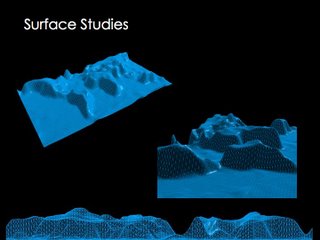http://www.biothing.org/
poli::mat
Wednesday, October 25, 2006
10.25
I recieved some very helpful comments after the review on Monday. The insight of the instructors was eye-opening and helped lead me in a new direction. Here is a review of some interesting points that were raised:
investigate how an impact effects different resistances (water vs. land vs. air)
moire's rebounding-->resistors producing rebounding
investigate wave form/wave distrubances
two simultaneous tsunami's?
resistances: dust settling; can these maps begin to have an identity/material quality that you can resist/ can different parts of the map react differently?
throw things at the "puddle that is the world"
ex: himalayas: concentrate waves? amplify? disperse?
who is spared?
what does an impact carry into the atmosphere?
multiple global scale events: palimpsest of various epicenters
many multiple scale events occuting simultaneously
evidence of flooding from some point, radiation from some point
scale of the ripple, thermonuclear...settlement
radiation tests from nuclear bombs
man made disasters; how they impact one another
There was a variety of comments and in continuing my mapping i hope to redirect my project to encorporate the bolded items.









investigate how an impact effects different resistances (water vs. land vs. air)
moire's rebounding-->resistors producing rebounding
investigate wave form/wave distrubances
two simultaneous tsunami's?
resistances: dust settling; can these maps begin to have an identity/material quality that you can resist/ can different parts of the map react differently?
throw things at the "puddle that is the world"
ex: himalayas: concentrate waves? amplify? disperse?
who is spared?
what does an impact carry into the atmosphere?
multiple global scale events: palimpsest of various epicenters
many multiple scale events occuting simultaneously
evidence of flooding from some point, radiation from some point
scale of the ripple, thermonuclear...settlement
radiation tests from nuclear bombs
man made disasters; how they impact one another
There was a variety of comments and in continuing my mapping i hope to redirect my project to encorporate the bolded items.










Monday, October 23, 2006
10.23
Friday, October 20, 2006
Thursday, October 19, 2006
Monday, October 16, 2006
10.16
rendering of the disturbed earth mesh, a representation of the spread of a shock wave post impact.
detail of ripple
this image shows the comparasson of the regular earth mesh (pre-impact) to the disturbed earth mesh (post-impact) this image is a study of how to layer/combine information.
this image is a study of how to layer/combine information. 
experimentation with controlled disturbance

detail of ripple

this image shows the comparasson of the regular earth mesh (pre-impact) to the disturbed earth mesh (post-impact)
 this image is a study of how to layer/combine information.
this image is a study of how to layer/combine information. 
experimentation with controlled disturbance

Sunday, October 15, 2006
10.15
In reconsidering the assignment I've decided to construct a layering map. This map will condition how the earth as a whole reacts and exists through a terrestrial impact event. When an impact occurs many large scale processes take place including the displacement of atmoshpere, land, water (megatsunami's), the occurance of global firestorms, acid rain, temperature abnormalities, seismic shaking, ejecta deposition, air blasts, and thermal radiation.
This is a lot of information. For this mapping I have selected thermal radiation, ejecta deposition, and air blasts to use as information for layering ontop of a topographic mesh model of the earth (seen below). To gather data I have located a program created by scientists at the University of Arizona. This is a web-based program that calculates the effects of an earth impact. The program can be located here. Using this program I will relate my chosen processes in terms of distance from a given location on the earth. Essentially mapping how the effects of a terrestrial impact diminish as distance from the point of origin is increased.


This is a lot of information. For this mapping I have selected thermal radiation, ejecta deposition, and air blasts to use as information for layering ontop of a topographic mesh model of the earth (seen below). To gather data I have located a program created by scientists at the University of Arizona. This is a web-based program that calculates the effects of an earth impact. The program can be located here. Using this program I will relate my chosen processes in terms of distance from a given location on the earth. Essentially mapping how the effects of a terrestrial impact diminish as distance from the point of origin is increased.



Subscribe to:
Posts (Atom)


